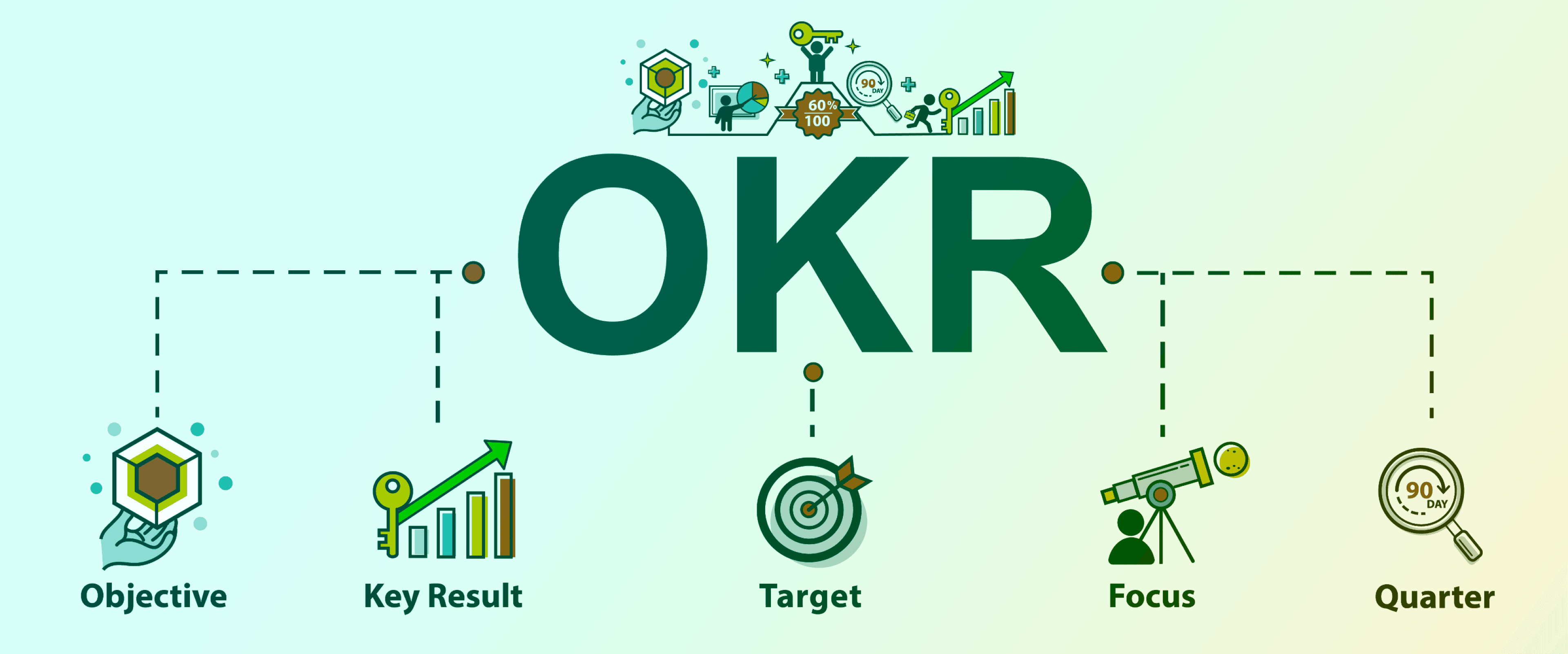OKR Metrics Explained | Setting, Measuring & Avoiding Mistakes
Understand OKR metrics with our in-depth guide. Learn how to set, measure, and grade OKRs effectively while avoiding common mistakes. Find out more!
March 3, 2023
In today's fast-paced business landscape, organisations are constantly seeking innovative ways to adapt and thrive. Two methodologies that have gained significant popularity in recent years are Agile and OKRs (Objectives and Key Results). Agile focuses on iterative development and collaboration, while OKRs provide a framework for setting measurable goals and tracking progress. When combined, Agile and OKRs create a powerful tool for driving organisational success. In this article, we will explore what OKRs in Agile are, how Objectives and Key Results are used in SAFe (Scaled Agile Framework), and provide examples of how Agile OKRs can help organisations achieve their goals and deliver results.

Agile is a methodology used in project management and software development that emphasises flexibility, collaboration, and customer satisfaction. Originating from the Agile Manifesto, Agile principles focus on delivering small, incremental changes rather than complete, large-scale projects. This approach allows teams to adapt quickly to changes and continuously improve their processes.
OKRs, which stand for Objectives and Key Results, are a goal-setting framework designed to help organisations define and track their objectives and outcomes. Introduced by Andy Grove at Intel, OKRs have been widely adopted by companies to ensure focus, alignment, and measurable progress.
Agile and OKRs complement each other by combining flexibility with structured goal-setting. Agile methodologies, such as Scrum and Kanban, promote an iterative approach, allowing teams to adapt quickly to changes and continuously improve their processes. This adaptability is crucial for achieving the ambitious goals set by OKRs.
For instance, the iterative cycles of Agile, often referred to as sprints, provide the perfect structure for working towards key results. Each sprint focuses on a specific set of tasks that contribute to the overall objectives. This way, Agile teams can regularly check their progress and make necessary adjustments to stay aligned with their goals.
Agile practices also foster a culture of collaboration and transparency, essential for the effective implementation of OKRs. Regular meetings, such as daily stand-ups and sprint reviews, ensure that everyone is on the same page and working towards the same objectives. This continuous communication helps in identifying and resolving issues promptly, ensuring that the team remains focused on the desired outcomes.

Aligning Agile methodologies with OKRs ensures that all team activities are directed towards achieving strategic objectives. OKRs provide a clear framework for setting and tracking goals, while Agile methodologies offer the flexibility needed to adapt to changes and overcome obstacles.
Define what the organisation aims to achieve in a way that inspires and guides the team. Objectives should be broad, qualitative goals that provide a clear direction. For example, an objective might be "Enhance product quality," which sets a high-level goal that drives the team's efforts.
Establish specific, time-bound, and quantitative measures that indicate progress towards the objectives. Key results should be SMART (Specific, Measurable, Achievable, Relevant, and Time-bound) to ensure clarity and focus. For instance, key results for the objective "Enhance product quality" could include "Reduce defect rates by 30%" and "Increase customer satisfaction scores to 90%."
Use Agile ceremonies, such as sprint planning and retrospectives, to review and adjust OKRs regularly. This integration ensures that the team’s activities align with the organisational goals and allows for continuous improvement. During sprint planning, teams can break down key results into actionable tasks and ensure that each sprint moves them closer to their objectives.
Leverage tools like Jira to track both Agile tasks and OKR progress. These tools provide real-time visibility into how well the team is progressing towards their key results, making it easier to adjust plans and priorities as needed. This dual tracking ensures that both day-to-day tasks and long-term goals are monitored effectively.
Encourage open communication and regular updates on OKR progress. This transparency ensures that everyone understands their role in achieving the objectives and can collaborate effectively to overcome any challenges. Regular check-ins and progress reports help maintain accountability and keep the team aligned with their goals.

Start by identifying what you aim to achieve. Objectives should be broad, qualitative, and inspiring. They provide a clear direction and set the stage for the key results. For example, an objective might be "Enhance product quality." This objective should be ambitious enough to motivate the team and align with the overall vision of the organisation.
For each objective, establish specific, time-bound, and quantitative measures. Key results should be SMART (Specific, Measurable, Achievable, Relevant, and Time-bound). For the objective "Enhance product quality," key results could include "Reduce defect rates by 30%" and "Increase customer satisfaction scores to 90%." These key results break down the objective into tangible, trackable outcomes that the team can work towards.
Use Agile sprints to break down key results into manageable tasks. Each sprint should contribute to achieving the key results. For instance, if one key result is to "Reduce defect rates by 30%," a sprint could focus on improving the testing process or implementing new quality assurance tools. This approach ensures that the team’s efforts are consistently aligned with the overall objectives and allows for iterative progress.
Engage team members in the OKR-setting process to ensure buy-in and commitment. When team members contribute to defining their objectives and key results, they are more likely to be motivated and take ownership of their goals. This involvement fosters a sense of responsibility and encourages a collaborative approach to achieving the set objectives.
Incorporate OKR reviews into regular Agile ceremonies such as sprint reviews and retrospectives. During these meetings, discuss the progress towards key results, identify any roadblocks, and make necessary adjustments. This regular review process ensures that OKRs remain relevant and aligned with the team’s ongoing work, allowing for timely interventions and course corrections.
Utilise tools like Jira to track both Agile tasks and OKR progress. These tools provide real-time visibility into how well the team is progressing towards their key results. By integrating OKRs into your project management tools, you can streamline the tracking process and ensure that everyone is on the same page. This integration helps in maintaining a clear and consistent overview of both short-term tasks and long-term goals.
Encourage open communication about OKR progress. Regular updates and transparent reporting help maintain accountability and ensure that everyone understands their role in achieving the objectives. This transparency fosters a culture of continuous improvement and collaboration, making it easier to address issues as they arise and keep the team aligned.
Be prepared to adjust your OKRs based on feedback and changing circumstances. Agile methodologies are designed to be flexible, so it’s important to adapt your OKRs as needed. If a key result becomes unattainable due to unforeseen challenges, reassess and modify your OKRs to ensure they remain relevant and achievable. This flexibility allows the team to stay responsive and focused on what matters most.
Recognise and celebrate when key results are achieved. Conversely, if objectives are not met, conduct a thorough review to understand what went wrong and how to improve in the future. This approach promotes a growth mindset and continuous learning within the team. Celebrating successes boosts morale, while learning from setbacks ensures that the team evolves and improves over time.
Utilise Agile project management tools like Jira, Trello, or Asana to track both Agile tasks and OKR progress. These tools help in planning, executing, and monitoring sprints and key results in real-time. For instance, Jira can be customised to include OKR tracking, allowing teams to link their day-to-day tasks directly to their objectives and key results. This integration provides a holistic view of progress and ensures that all team activities align with organisational goals.
Invest in specialised OKR software such as Weekdone, Lattice, or 15Five. These platforms are designed to streamline the OKR process, from setting objectives to tracking key results and providing regular updates. OKR software often includes features for progress tracking, performance analytics, and visual dashboards, which can enhance transparency and accountability within the team. These tools make it easier to maintain a clear focus on strategic objectives while managing the details of daily work.
Schedule regular check-ins and reviews to discuss OKR progress. Agile ceremonies such as sprint reviews, retrospectives, and daily stand-ups provide natural opportunities to review key results and adjust plans as needed. During these meetings, teams can evaluate their performance, identify any roadblocks, and make necessary adjustments to stay on track. Regular reviews ensure that OKRs remain relevant and aligned with current priorities and challenges.
Use real-time dashboards and reporting tools to maintain visibility into OKR and Agile task progress. Tools like Power BI, Tableau, or the reporting features within your project management software can provide visual representations of how well the team is performing against their objectives. These dashboards can be customised to show key metrics, trends, and progress updates, making it easier to communicate status and make informed decisions.
Implement a continuous feedback loop to gather insights and make improvements. Agile methodologies emphasise the importance of feedback and iteration, which aligns well with the adaptive nature of OKRs. Encourage team members to provide feedback on both processes and outcomes regularly. Use this feedback to refine your OKR strategy, improve collaboration, and address any issues promptly. Adapting based on feedback helps maintain agility and ensures that the team can respond effectively to changing circumstances.
Combining Agile methodologies with OKRs (Objectives and Key Results) creates a powerful framework for organisational success by aligning flexibility with clear, measurable goals. Agile practices foster adaptability and continuous improvement, while OKRs provide strategic direction and accountability. By leveraging the right tools and techniques, such as Agile project management software, specialised OKR platforms, regular reviews, and real-time dashboards, organisations can ensure seamless integration and effective tracking of progress. This dynamic approach enables teams to achieve ambitious objectives while maintaining the agility to respond to changing circumstances, driving sustained success and growth.
Bleiben Sie auf dem Laufenden mit allem, was Sie wissen müssen.
Understand OKR metrics with our in-depth guide. Learn how to set, measure, and grade OKRs effectively while avoiding common mistakes. Find out more!
Discover the 7 benefits of OKR methodology, including clear communication, improved focus, and increased profitability. Learn more about OKR advantages!
Discover 5 essential tips for effective OKR goal setting. Learn how to identify objectives, involve team members, and set realistic expectations. Read more!